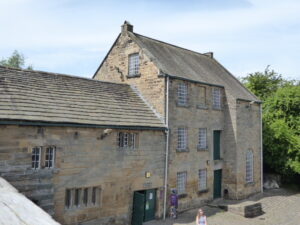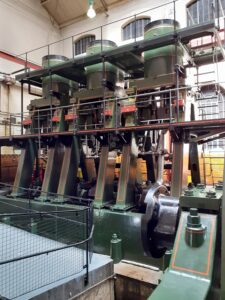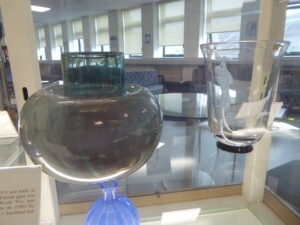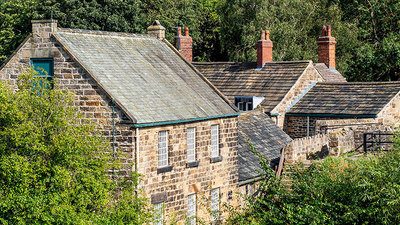What’s on : Activities
Event Information
Bread and Steel: Visit to South Yorkshire
Thursday 16th June 2022 from 8.30am to 6pm
£30 per person
Our first visit is to Worsborough Mill and Country Park where we will have a talk with Simon, the Miller, and enjoy an included takeaway drink from the Miller’s Café. We continue by coach to Sheffield to the Kelham Island Museum where we will visit the 1916 Sheffield Street, see the Sheffield Simplex car and a demonstration of craft skills, with time to explore other Museum exhibits including the River Don Steam Engine demonstration at 2pm. At 3pm we plan to visit the Glass Museum at the University of Sheffield. The fee includes morning drink, coach travel, driver gratuity, museum donation and £3 YPS admin. Members of York Association of the National Trust (YANT) are most welcome to join us.
The York Pullman coach will leave from Memorial Gardens at 8.30am, leaving Sheffield at 4.15pm for the return journey. Lunch is not included; there is the Island Café and the Millowners Arms, both at Kelham Island, details of lunches can be sent to you or bring your own picnic.
Member’s report
South Yorkshire conjures up images of pounding machinery and smoking chimneys, so we were surprised, at the first stop on this coach excursion, to find ourselves in the heart of the tranquil woodland of Worsborough Country Park on the outskirts of Barnsley. Sites like this on the River Dove saw the development of early water- powered industry, and the 17th century corn mill, its overshot wheel, more than 4 metres in diameter, turned by water collected in a mill pond higher up the valley side, may stand on the site of one recorded in Domesday Book. In the 1840s, to meet demand from a growing local population, the building was extended and a second mill installed, powered by steam and later by oil. Our tour, guided by present miller, Simon Dodd, took in both mills with their five pairs of stones, made of coarse gritstone from Derbyshire for grinding animal feed and French burr (quartz) for finer flour, wooden hoppers and spouts and baffling system of drive shafts and cogs. After years of experience Simon judges the performance of the mill by sound and vibration, the feel and smell of the flour and an alarm bell he invented to warn against over-heating of the stones, flour being highly combustible. He must also be mindful of the amount of water used, limited by licence, and of course the income generated by sales of the end product. Many of us helped with this by visiting the shop before our departure.
powered industry, and the 17th century corn mill, its overshot wheel, more than 4 metres in diameter, turned by water collected in a mill pond higher up the valley side, may stand on the site of one recorded in Domesday Book. In the 1840s, to meet demand from a growing local population, the building was extended and a second mill installed, powered by steam and later by oil. Our tour, guided by present miller, Simon Dodd, took in both mills with their five pairs of stones, made of coarse gritstone from Derbyshire for grinding animal feed and French burr (quartz) for finer flour, wooden hoppers and spouts and baffling system of drive shafts and cogs. After years of experience Simon judges the performance of the mill by sound and vibration, the feel and smell of the flour and an alarm bell he invented to warn against over-heating of the stones, flour being highly combustible. He must also be mindful of the amount of water used, limited by licence, and of course the income generated by sales of the end product. Many of us helped with this by visiting the shop before our departure.
 A water-powered corn mill was also the origin of Kelham Island, formed in the 1100s when a stream was diverted to drive the wheel but, with coal, iron ore and sandstone available locally, knife-making was already going on by the time Chaucer wrote of a “Sheffeld thwitel”, and succeeding centuries saw the development of a major industrial area. The Kelham Island Museum, our second destination, reveals this history through a magnificent collection of artefacts, from the Bessemer converter on guard at its entrance, in use until 1974 and one of only three left in the world, to the exquisite tools and cutlery made for the Great Exhibition where Sheffield filled more floor space than any other city. Our highlight was seeing “The Don” in operation. At over 8 metres high and weighing 420 tonnes, this 3-cylinder, 12000 horsepower engine was built in 1905 to roll armour plating for warships. To avoid cooling of the metal it was vital that the huge engine could accelerate and reverse extremely quickly; as we witnessed, it still can.
A water-powered corn mill was also the origin of Kelham Island, formed in the 1100s when a stream was diverted to drive the wheel but, with coal, iron ore and sandstone available locally, knife-making was already going on by the time Chaucer wrote of a “Sheffeld thwitel”, and succeeding centuries saw the development of a major industrial area. The Kelham Island Museum, our second destination, reveals this history through a magnificent collection of artefacts, from the Bessemer converter on guard at its entrance, in use until 1974 and one of only three left in the world, to the exquisite tools and cutlery made for the Great Exhibition where Sheffield filled more floor space than any other city. Our highlight was seeing “The Don” in operation. At over 8 metres high and weighing 420 tonnes, this 3-cylinder, 12000 horsepower engine was built in 1905 to roll armour plating for warships. To avoid cooling of the metal it was vital that the huge engine could accelerate and reverse extremely quickly; as we witnessed, it still can.
 1905 also saw the foundation of Sheffield University with its aim of developing expertise for local industry. When imports of good quality glass from Germany were halted by World War I, a chemistry lecturer, W E S Turner, recognized the need for improvement of British glass production and was appointed head of a new Department of Glass Technology. Over the years his role brought him into contact with leading manufacturers and designers throughout the world, and the collection of art glass he was able to build up, many pieces made especially for him or in his presence, was donated to the University in 1943 “as a counterbalance to the technical activities in which the department is engaged”. Our final destination of the day, the Turner Museum of Glass exhibits masterpieces of the glassmaker’s art from across the globe, from the simple perfection of Scandinavian design to exuberant Italian millefiori, but most memorable was the rich blue dress, hat and bag worn by Mrs Turner on her wedding day, all made from fibreglass.
1905 also saw the foundation of Sheffield University with its aim of developing expertise for local industry. When imports of good quality glass from Germany were halted by World War I, a chemistry lecturer, W E S Turner, recognized the need for improvement of British glass production and was appointed head of a new Department of Glass Technology. Over the years his role brought him into contact with leading manufacturers and designers throughout the world, and the collection of art glass he was able to build up, many pieces made especially for him or in his presence, was donated to the University in 1943 “as a counterbalance to the technical activities in which the department is engaged”. Our final destination of the day, the Turner Museum of Glass exhibits masterpieces of the glassmaker’s art from across the globe, from the simple perfection of Scandinavian design to exuberant Italian millefiori, but most memorable was the rich blue dress, hat and bag worn by Mrs Turner on her wedding day, all made from fibreglass.
Thanks must go to Catherine Brophy for putting together such a fascinating day which expanded our appreciation of the wealth of South Yorkshire’s industrial history.
Frances Chambers
Photos: Worsborough Mill by Frances Chambers; The Don Engine by Shirley Bibby; Exhibits in the Turner Museum by Frances Chambers

